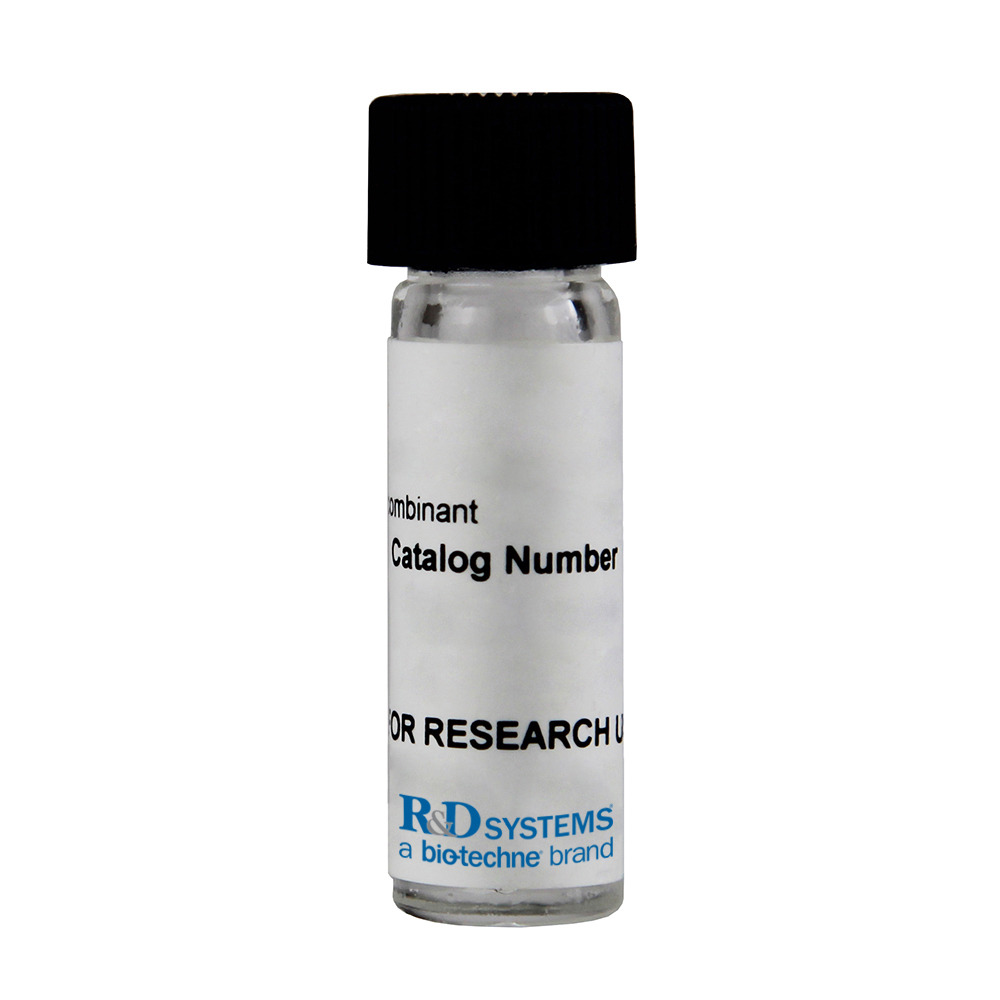

 下载产品说明书
下载产品说明书 下载SDS
下载SDS 用小程序,查商品更便捷
用小程序,查商品更便捷



 收藏
收藏
 对比
对比 咨询
咨询Carrier Free
CF stands for Carrier Free (CF). We typically add Bovine Serum Albumin (BSA) as a carrier protein to our recombinant proteins. Adding a carrier protein enhances protein stability, increases shelf-life, and allows the recombinant protein to be stored at a more dilute concentration. The carrier free version does not contain BSA.
In general, we advise purchasing the recombinant protein with BSA for use in cell or tissue culture, or as an ELISA standard. In contrast, the carrier free protein is recommended for applications, in which the presence of BSA could interfere.
3868-AV
| Formulation | Lyophilized from a 0.2 μm filtered solution in PBS. |
| Reconstitution | Reconstitute at 100 μg/mL in sterile PBS. |
| Shipping | The product is shipped at ambient temperature. Upon receipt, store it immediately at the temperature recommended below. |
| Stability & Storage: | Use a manual defrost freezer and avoid repeated freeze-thaw cycles.
|
Recombinant Human Integrin alpha L beta 2 Protein, CF Summary
Product Specifications
| Human Integrin alpha L (Tyr26-Met1089) Accession # P20701 | acidic tail |
| Human Integrin beta 2 (Gln23-Asn700) Accession # P05107 | basic tail |
| N-terminus | C-terminus |
Analysis

Background: Integrin alpha L beta 2
Integrin alpha L beta 2, also called LFA-1, is one of three beta 2 integrin adhesion proteins. The non-covalent heterodimer of 180 kDa alpha L/CD11a and 95 kDa beta 2/CD18 integrin subunits is expressed on virtually all leukocytes (1-3). The ligand binding site of LFA-1 is in the N-terminal head region, formed by an interaction of the vWFA (I, I‑like) domains from each subunit, and the alpha L beta-propeller structure (3-5). The alpha L subunit contains domains termed thigh, calf-1 and calf-2, while the beta 2 subunit contains a PSI (plexin-semaphorin-integrin) region and four cysteine-rich I-EGF folds (5, 6). Each subunit has a transmembrane sequence and a short cytoplasmic tail connected to the cytoskeleton. Upon activation by “inside-out” signaling, clustering, or Mg2+ or Mn2+ binding to metal ion-dependent adhesion sites (MIDAS) within the vWFA domains, the molecule unfolds from its inactive, “closed” conformation to expose ligand binding sites (3, 6-9). Active alpha L beta 2 binds ICAM-1/CD54, ICAM-2, ICAM‑3 and JAM‑A (1, 10-12). The adhesion stabilizes interactions between T cells and antigen-presenting cells, decreases the T cell activation threshold, and facilitates leukocyte transendothelial migration to sites of inflammation (12-14). A constitutively active construct severely impairs immune responses, demonstrating that both activation and de-activation are important (14). Mutations of beta 2, especially in the vWFA domain, cause leukocyte adhesion deficiency (LAD-1) and susceptibility to bacterial infections (15). The 1088 amino acid (aa) human alpha L/CD11b ECD is 73-74% aa identical to mouse and rat, and 79-80% aa identical to bovine, porcine, ovine, goat and canine alpha L ECD. A second human alpha L isoform has 53 aa inserted after aa 954 in the ECD. The 678 aa human beta 2/CD18 ECD shares 81-83% aa sequence identity with mouse, rat, bovine, canine, goat, ovine, and porcine beta 2 ECD.
- Larson, R.S. et al. (1989) J. Cell Biol. 108:703.
- Kishimoto, T.K. et al. (1987) Cell 48:681.
- Hynes, R.O. (2002) Cell 110:673.
- Qu, A. and D.J. Leavy (1995) Proc. Natl. Acad. Sci. USA 92:10277.
- Shi, M. et al. (2005) J. Biol. Chem. 280:30586.
- Beglova, N. et al. (2002) Nat. Struct. Biol. 9:282.
- Shimaoka, M. et al. (2003) Immunity 19:391.
- Lu, C. et al. (2004) J. Immunol. 173:3972.
- Cairo, C.W. et al. (2006) Immunity 25:297.
- Nortamo, P. et al. (1991) J. Immunol. 146:2530.
- de Fougerolles, A.R. and T.A. Springer (1992) J. Exp. Med. 175:185.
- Ostermann, G. et al. (2002) Nat. Immunol. 3:151.
- Heit, B. et al. (2005) J. Cell Sci. 118:5205.
- Semmrich, M. et al. (2005) J. Exp. Med. 201:1987.
- Kishimoto, T.K. et al. (1987) Cell 50:193.









 危险品化学品经营许可证(不带存储) 许可证编号:沪(杨)应急管危经许[2022]202944(QY)
危险品化学品经营许可证(不带存储) 许可证编号:沪(杨)应急管危经许[2022]202944(QY)  营业执照(三证合一)
营业执照(三证合一)